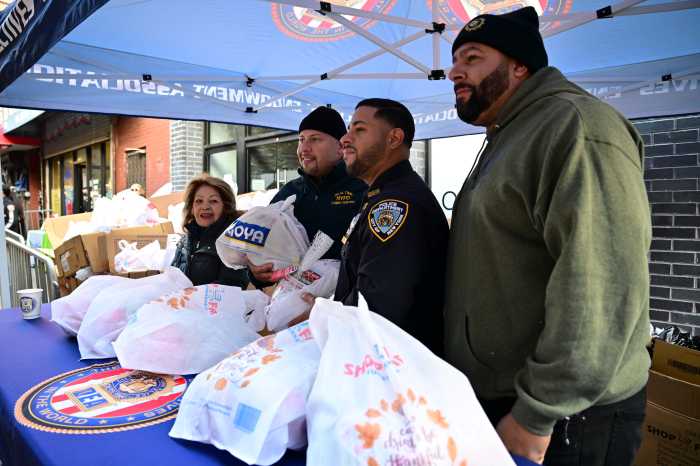Michael Sandy, who died in 2006 after being lured to a Brooklyn beach on a gay hookup site and then chased onto the Belt Parkway, where he was struck by a car. | MICHAEL SANDY FOUNDATION
While the director and writer of “Beach Rats,” a critically acclaimed film, has said her story was inspired by her experience of attending high school with kids from South Brooklyn and spending time in that area, the plot is based entirely on the 2006 killing of a black gay man by four South Brooklyn teens.
The indie film by Eliza Hittman tells the story of Frankie, a troubled and closeted gay teen, and his three friends — Alexei, Nick, and Jesse. Frankie is struggling to maintain a relationship with a girl while meeting older gay men for sex via an online hookup site. Late in the film, the four want to get some marijuana and Frankie suggests they find a gay man on the hookup site to steal some pot from. That man, Jeremy, first appears, but leaves after seeing that there are four men when he expected to meet just Frankie. After the four return to Frankie’s home, Jeremy gets back in touch and arranges a second meeting with Frankie alone. Frankie and Jeremy drive to a nearby highway rest stop next to a beach where the other three are waiting. When Jeremy shows up, he is attacked by Nick and Alexei on the beach. It does not appear that Jeremy has been killed, but the ending is ambiguous.
In 2006, Anthony Fortunato, John Fox, Ilya Shurov, and Gary Timmins, four South Brooklyn teens, arranged a meeting online with Michael Sandy, a black gay man, to steal some pot from him. Fortunato, who had a girlfriend but was meeting gay men for sex on an online hookup site, suggested using the online site, but unlike “Beach Rats,” here Fox pretended to be gay. Sandy arrived, but left after seeing four men instead of just Fox. Sandy soon got back in touch and arranged a second meeting with Fox alone. The two drove to a rest stop off the Belt Parkway next to Plumb Beach where the other three were waiting. When they arrived, Shurov attacked Sandy who fled on to the parkway. Fox also pursued Sandy. On the parkway, Shurov pushed Sandy into the path of an oncoming car that struck and killed the 29-year-old.
ETHICS: “Beach Rats” clearly based on Michael Sandy slaying; director points to her upbringing
Like the movie, Fortunato lived with his mother and had a younger sister, had a father who died from cancer before the violent attack on the older gay man, and had a drug problem. Unlike the Sandy story, Jeremy is a white gay man.
There are other links between the Fortunato story and “Beach Rats.”
In 2007, Fortunato and Fox were tried together, but with separate juries. Among the prosecution witnesses was Richie Folio, who knew the four men. In her 2013 film, “It Felt Like Love,” Hittman cast a Richie Folio. Hittman uses “non-traditional” casting. The actors who played Nick, Jesse, and Alexei were untrained and recruited from South Brooklyn.
Hittman obtained a city permit from the Mayor’s Office of Media and Entertainment to film portions of “Beach Rats,” including the attack on Jeremy, at the rest stop where Sandy was killed in 2006.
Fortunato was found guilty of manslaughter as a hate crime and was paroled last year. Fox was convicted on manslaughter and two attempted robbery counts, all as hate crimes. Fox is eligible for parole. After the Fortunato and Fox convictions, Shurov pleaded guilty to manslaughter and attempted robbery, both as hate crimes. His first parole date is in 2021. Timmins cooperated with the prosecution and served four years.
The thugs who lured a gay man to the same beach where Michael Sandy was killed as depicted in Eliza Hittman’s “Beach Rats.” | NEON
At an August 27 screening of “Beach Rats” at Lincoln Center, Hittman refused to answer any questions from Gay City News. In an August 29 written response, she said, “As a Brooklyn native, I’m aware of the Anthony Fortunato story as well as numerous other cases of intolerance and injustice towards the gay community. I did not set out to make a biopic or tell anyone’s personal story. Like my other films, ‘Beach Rats’ explores the fragility and danger of teenage sexuality. And it’s intended as a poetic exploration of the pressures of masculinity and an identity crisis as a catalyst for violence, which is unfortunately all too common. Growing up in Brooklyn, I’ve witnessed first-hand instances of homophobia in my own upbringing and community, all of which influenced the writing of this story.”
Gay City News could not find instances where Hittman claimed that “Beach Rats” was her original work, but she has certainly left that impression by saying in multiple interviews and at screenings that the story arose from her experience of attending Edward R. Murrow High School with peers from South Brooklyn and time spent in that neighborhood.
“When I was thinking about ‘Beach Rats,’ I spent a lot of time in this park in Manhattan Beach that’s right on the water and observing guys play handball,” Hittman told the Village Voice in an August 22 interview.
Gay City News could not find a single instance of Hittman saying that “Beach Rats” was based on the Sandy killing. The closest she has come was in an interview with Steve Erickson, a Gay City News film reviewer, in which she said the movie was inspired by gay-baiting crimes, but she did not mention any specific cases. Erickson knew of the Sandy killing, and he interviewed Hittman for another publication.
In an email, Steven Maras, a professor at the University of Western Australia who has published on the ethics of screenwriting, wrote that filmmakers should disclose.
“It is a good idea to either base the story honestly around an accepted set of facts or seek the consent or collaboration of the sources, or use appropriate disclaimers to properly recognise the origins of the program or use a story ‘inspired by events’ credit,” wrote Maras who has not seen “Beach Rats” and was not familiar with the Sandy case. “The film industry and film makers often have ways of just talking about their ‘material’ or their story as though it circulates in a vacuum… so they don’t always tend to the cultural side, and this can become an issue for groups who do not feel their voices to be heard.”















